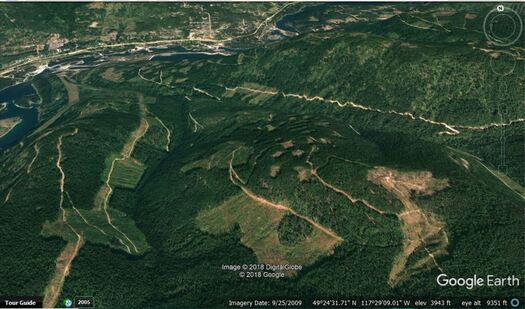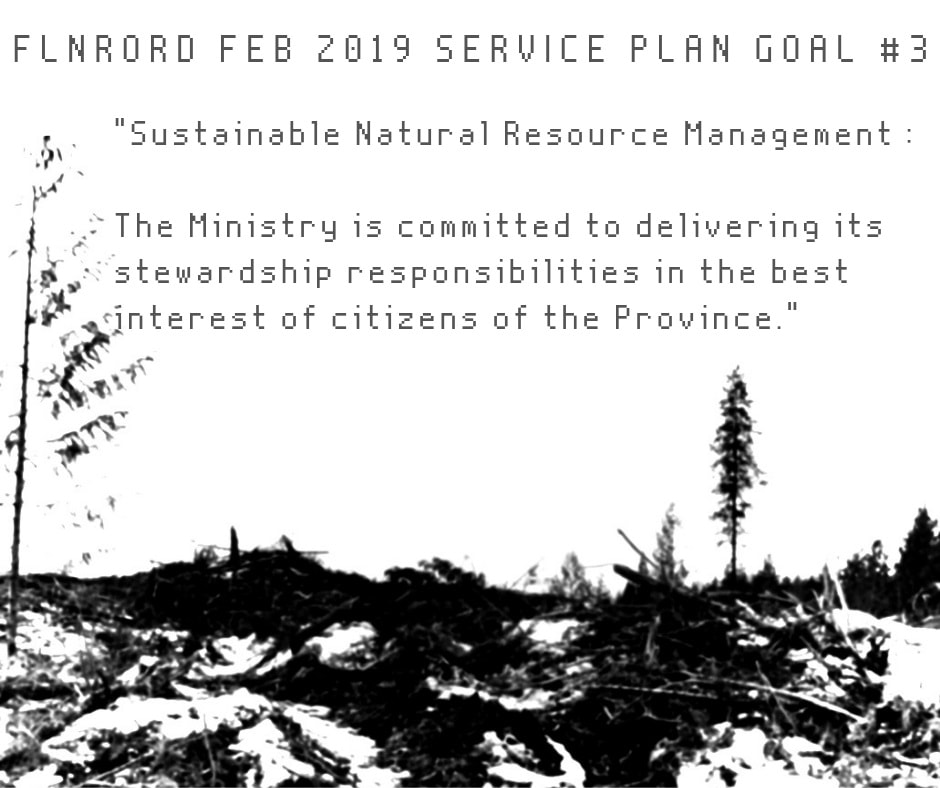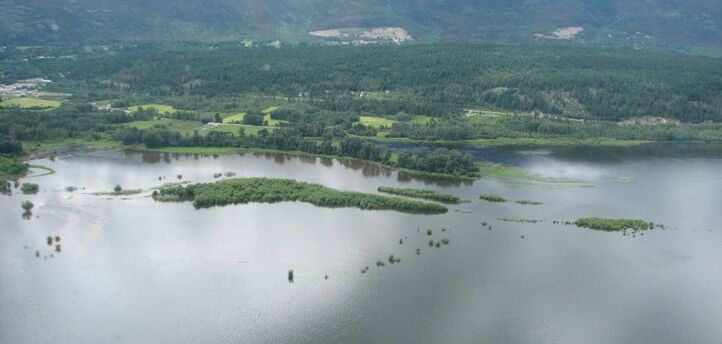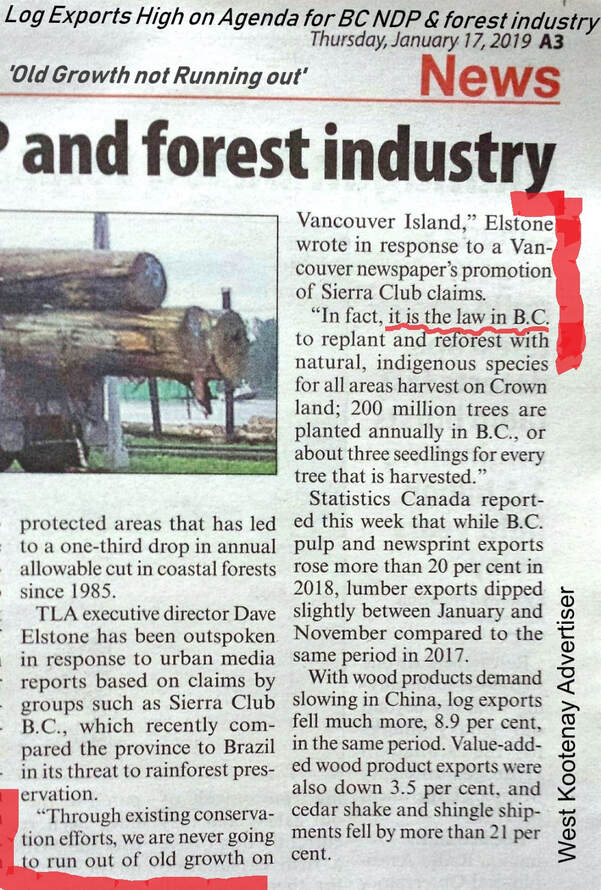'Sustainable' and 'Renewable' Resource?
 Cutblocks outside of our watershed. Glade community is off the page on the left.
Cutblocks outside of our watershed. Glade community is off the page on the left.
Read any logging literature, speak to any member of the industry, and the words most often spoken are 'sustainable', and 'renewable'.
Like Mike Elstone of the Truck Logger's Association stating: "Let me be clear: B.C. is the most sustainably managed forest region in the world." (https://theprovince.com/opinion/op-ed/david-elstone-logging-doesnt-threaten-old-growth-forests)
Or this quote from the Interior Lumber Manufacturer's Association (ILMA Aug2016) Solutions pamphlet: "Our forests are a cherished renewable resource essential to both our economic future and the spirit of all British Columbians."
In 2013, this 'sustainable resource' was not enough for the ILMA, who petitioned the Regional District of Central Kootenay and the provincial government for a review of the timber supply in the Kootenays. (Article HERE) The demand was exceeding the supply, so the lumber companies in this area needed to cut more timber, and wanted land use restrictions in the Kootenays changed to accommodate that need. And again, in 2016, the Interior Lumber Manufacturers Association went to the RDCK and asked the RDCK "to support their call for the province to change timber harvesting regulations".
2013, Ramona Faust, Area E Director, RDCK, responds to their request.
(in part: read full letter & background information HERE)
Like Mike Elstone of the Truck Logger's Association stating: "Let me be clear: B.C. is the most sustainably managed forest region in the world." (https://theprovince.com/opinion/op-ed/david-elstone-logging-doesnt-threaten-old-growth-forests)
Or this quote from the Interior Lumber Manufacturer's Association (ILMA Aug2016) Solutions pamphlet: "Our forests are a cherished renewable resource essential to both our economic future and the spirit of all British Columbians."
In 2013, this 'sustainable resource' was not enough for the ILMA, who petitioned the Regional District of Central Kootenay and the provincial government for a review of the timber supply in the Kootenays. (Article HERE) The demand was exceeding the supply, so the lumber companies in this area needed to cut more timber, and wanted land use restrictions in the Kootenays changed to accommodate that need. And again, in 2016, the Interior Lumber Manufacturers Association went to the RDCK and asked the RDCK "to support their call for the province to change timber harvesting regulations".
2013, Ramona Faust, Area E Director, RDCK, responds to their request.
(in part: read full letter & background information HERE)
(Sept 3, 2013) There may be ways to retain the volume of timber available such as focusing timber harvesting on interface fire fuel reduction surrounding populated areas while still retaining current viewscape and watershed values that homeowners and tourism depend on...If the local mills in question have been stewarding the land for decades and trees are a crop then the shortfall in timber should not be long lived because second growth should be catching up... Lodgepole Pine has faced infestation and mortality and it comprises 20 to 25 per cent of the local timber land base which affects long term timber supply, however, it is a natural process and timber volumes should adjust for that.
As a director with ...forested areas adjacent to my electoral area and with a drainage that has already suffered a significant landslide at Laird Creek, I don’t know what was discussed by the directors that attended the meeting, nor the mills in attendance and that is an uncomfortable position, but I have to trust that there will not be a re-evaluation of the West Kootenay Boundary Land Use Plan that results in a reduction in parks, critical habitat or drinking watershed protection. These values were established through an exhaustive scientific and public outreach program (Commission on Resources and the Environment) and subsequent modifications to Forest Stewardship Planning processes have reduced public input opportunities.
The support we provide for one sector of the business community with ministerial advocacy begs the question: can the RDCK offer such support to other business sectors and non-profits that carry out vital work and contribute to the community?
|
the answer to sustainability...waiting a couple of decades until the trees grow back...? From an article in the Nelson Daily News:
“The logging industry is saying it’s sustainable,” ... “but then why are they in the watershed?” |
A problem with this statement is that it is doubtful that any profit- driven business will want to suffer a couple of 'tight decades', and cutting plantation trees is not sustainable. Every time a cut is made, the ecosystem is damaged to such an extent that the chances of trees growing back is reduced each time. |
Are Non Sustainable Practices Leading to a Lack of Wood?
Even though the industry and the Ministry of Forests keeps telling the public and stakeholders that the timber resources are renewable and sustainable, everyone in the industry also speaks about the lack of resources.
When asked why they were logging in watersheds, almost everyone in the industry maintains it is because of lack of available wood in other areas and also that watershed areas are now included in the timber harvest area by the government.
Even though the industry and the Ministry of Forests keeps telling the public and stakeholders that the timber resources are renewable and sustainable, everyone in the industry also speaks about the lack of resources.
When asked why they were logging in watersheds, almost everyone in the industry maintains it is because of lack of available wood in other areas and also that watershed areas are now included in the timber harvest area by the government.
As in this comment from an ILMA presentation overview:
It is often said, “look they have overcut everywhere else and now they have to come here” The facts are, that almost all crown watersheds are part of the Timber Harvesting Landbase (THLB) and have been used to calculate the Allowable Annual Cuts (AAC) in this province.
Or this comment from a meeting with the Kalesnikoff RPF:
When someone commented that it was unfortunate that logging companies had to log in watersheds, the answer from a Woodlands Manager was that if there was no logging in watersheds, 'there wouldn't be any wood for building homes'. (Apr2017)
Or this comment from Minister Donaldson. This is from a dialogue in the House of Representatives. Shuswap MLA Greg Kyllo brought forward concerns about flooding, loss of life and loss of property for his constituents. "I think we all appreciate that increased logging activity does increase water flows through different watersheds."(from a House transcript, 2019)
Hon. D. Donaldson: Thank you for bringing this matter forward, Member. I understand there are high sensitivities from the people who live there — relating to hydrological issues. Again, this area is part of the timber-harvesting land base...
The Canadian Centre for Policy Alternatives published a piece (2012) titled: BC Mills are Quickly Running Out of Wood. It reads in part:
Providing hope to people and communities wracked by horrific events (Burns Lake Mill explosion and fire) is not only understandable it’s essential. But what the provincial government offers instead is false hope – a dangerously backwards plan. Instead of acknowledging that consumption must align with what the forests can sustain, the government seeks to bend supply to demand. It’s a recipe for even more job losses in future years as the government kicks the problem down the road.
Not Planting Enough Trees:
And then there is this: in 2012, the Auditor General of BC released a report finding "that the government has failed to plant enough trees to ensure a healthy forest industry in the future" and that "significant areas of the forest are presently damaged by wildfire, diseases or pests such as mountain pine beetle, and the decision whether to replant lies with government," Auditor General Doyle wrote. "Unlike industry, government is not legally obligated to reforest. As such, very limited replanting has occurred." This hardly seems like a sustainable practice. (Article BC Government Killing Forest Industry here.)
And then there is this: in 2012, the Auditor General of BC released a report finding "that the government has failed to plant enough trees to ensure a healthy forest industry in the future" and that "significant areas of the forest are presently damaged by wildfire, diseases or pests such as mountain pine beetle, and the decision whether to replant lies with government," Auditor General Doyle wrote. "Unlike industry, government is not legally obligated to reforest. As such, very limited replanting has occurred." This hardly seems like a sustainable practice. (Article BC Government Killing Forest Industry here.)
Cutting Immature Trees and Cheap Trees:
It used to be that a mature tree was considered to be 120 years old. In the mid 90's this restriction was reduced to 80 years old, so now younger, smaller trees could be cut down. Likely because, even then. they were not being cut at a sustainable rate.
This complaint against ATCO, investigated by the Forest Practices Board suggests that there is not enough wood:
In 2001, a complaint was received by the Forest practices Board that alleged ATCO Lumber Ltd. was cutting immature timber around Nelson, BC without regard to the future value of the timber. Although, amazingly, there is no provincial standard for harvesting age, the District Manager generally considers mixed Douglas stands less that 80 years old to be immature. An investigation by the Ministry of Forests found that the trees being cut by ATCO were an average age of 81 years old, so ATCO had not contravened the Code.
Now, is the lack of wood meant in a physical sense, for example, there are not enough trees? Or are the logging companies saying there are not enough cheaply sourced trees, as in Canal Flats, BC?
Canfor (a company that made almost 4 billion dollars in sales in 2015) closed down the sawmill in Canal Flats one month before Christmas, putting 10% of the town out of work. A spokesperson for Canfor said that: "poor markets... combined with a lack of economically available fibre for the mill" caused the closure. (emphasis added).
Another way towards sustainability? Magical Thinking
From the President of the Truck Loggers Association: "...we are never going to run out of old growth..."
Yes, Dave, we will just replant those 800 year old trees...
From the President of the Truck Loggers Association: "...we are never going to run out of old growth..."
Yes, Dave, we will just replant those 800 year old trees...
..




